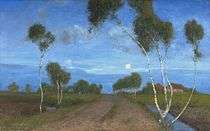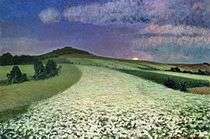Fritz Overbeck
August Friedrich Overbeck, known as Fritz (15 September 1869 in Bremen – 8 June 1909 in Vegesack) was a German painter and engraver.[1]

Biography
He was the son of the Technical Director at Norddeutscher Lloyd. After graduating from the local Gymnasium, he attended the Kunstakademie Düsseldorf from 1889 to 1893. Among his teachers there were Eugen Dücker and Peter Janssen. In 1894, he was persuaded by Otto Modersohn to set up a studio at the Artists' Colony in Worpswede, where he became fascinated with painting the desolate moorlands.[1]
In 1897, he married one of his students, Hermine Rohte, who had sought him out as a teacher after seeing an exhibition of his works at the Munich Glaspalast. She would also achieve some fame as a painter. Their son, Fritz Theodor Overbeck, was a noted botanist.
Around 1900, he became one of the many artists who were selected in a series of contests to design trading cards for the chocolate-maker Ludwig Stollwerck.[2] In 1905, after Hermine was diagnosed with tuberculosis, he and his family moved to Vegesack, where he specialized in painting the beaches and sand dunes.[1] He later became a member of the Deutscher Künstlerbund.
In 1909 he died, suddenly, from a stroke. He was buried at the Waller Friedhof in Bremen. Hermine survived her illness and devoted much of her time to promoting his work.
In 1990, his granddaughter Gertrud established the "Fritz and Hermine Overbeck Foundation", to preserve and publicize his work. In 2010, she was awarded the Order of Merit of the Federal Republic of Germany for her efforts.[3]
Overbeck's use of primary colors
 Evening in the Moor (1896)
Evening in the Moor (1896) The Setting Sun (c.1900)
The Setting Sun (c.1900) Flowering Buckwheat Field (c.1900)
Flowering Buckwheat Field (c.1900)
Writings
- Ein Brief aus Worpswede. in: Kunst für Alle XI (1895/96), S. 20-24.
References
- Renate Wiehager (1999), "Overbeck, Fritz", Neue Deutsche Biographie (NDB) (in German), 19, Berlin: Duncker & Humblot, pp. 725–726; (full text online)
- Goldoni, Maria: "Eine Stollwerck-Serie von Heinrich Vogeler und Franz Eichert" in Tagungsband Esslingen 2002, Arbeitskreis Bild, Druck & Papier.
- Gertrud Overbeck mit dem Bundesverdienstkreuz ausgezeichnet, senatspressestelle.bremen.de, abgerufen am 26. April 2011
Further reading
- Rainer Maria Rilke: Worpswede. Fritz Mackensen, Otto Modersohn, Fritz Overbeck, Hans am Ende, Heinrich Vogeler. Velhagen & Klasing, Bielefeld und Leipzig 1902 (Digitalized, E-Text); Neuausgabe: Insel Verlag, Frankfurt am Main 1987 und öfter, ISBN 978-3-458-32711-0
- Sigrid Weltge-Wortmann: Die ersten Maler in Worpswede. Eine Biographie des Künstlerdorfes und der Maler Fritz Mackensen, Otto Modersohn, Fritz Overbeck, Hans am Ende, Heinrich Vogeler und Paula Modersohn-Becker. Erweiterte Ausgabe. Worpsweder Verlag, Bremen 2003, ISBN 3-922516-00-9.
- Katja Pourshirazi, Antje Modersohn and Gertrud Overbeck (Eds.): Otto Modersohn und Fritz Overbeck. Der Briefwechsel, Wienand, 2014, ISBN 978-3-86832-198-2.
External links
| Wikimedia Commons has media related to Fritz Overbeck. |
- Literature by and about Fritz Overbeck in the German National Library catalogue
- Overbeck-Museum, Bremen
- Rainer Maria Rilke on Overbeck